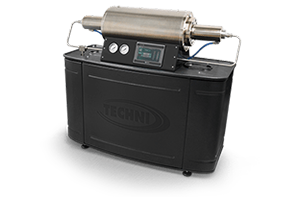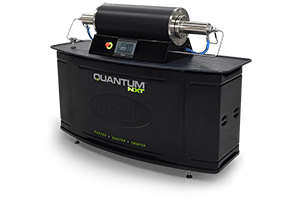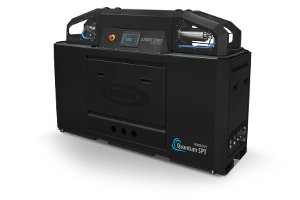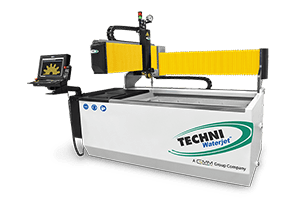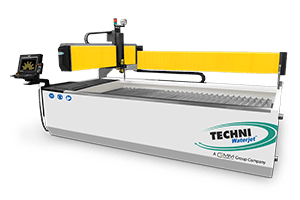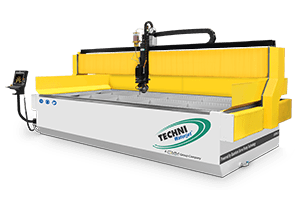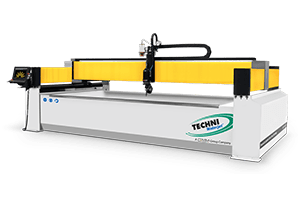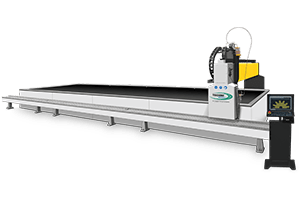CNC Laser Cutting vs Water Jet Cutting
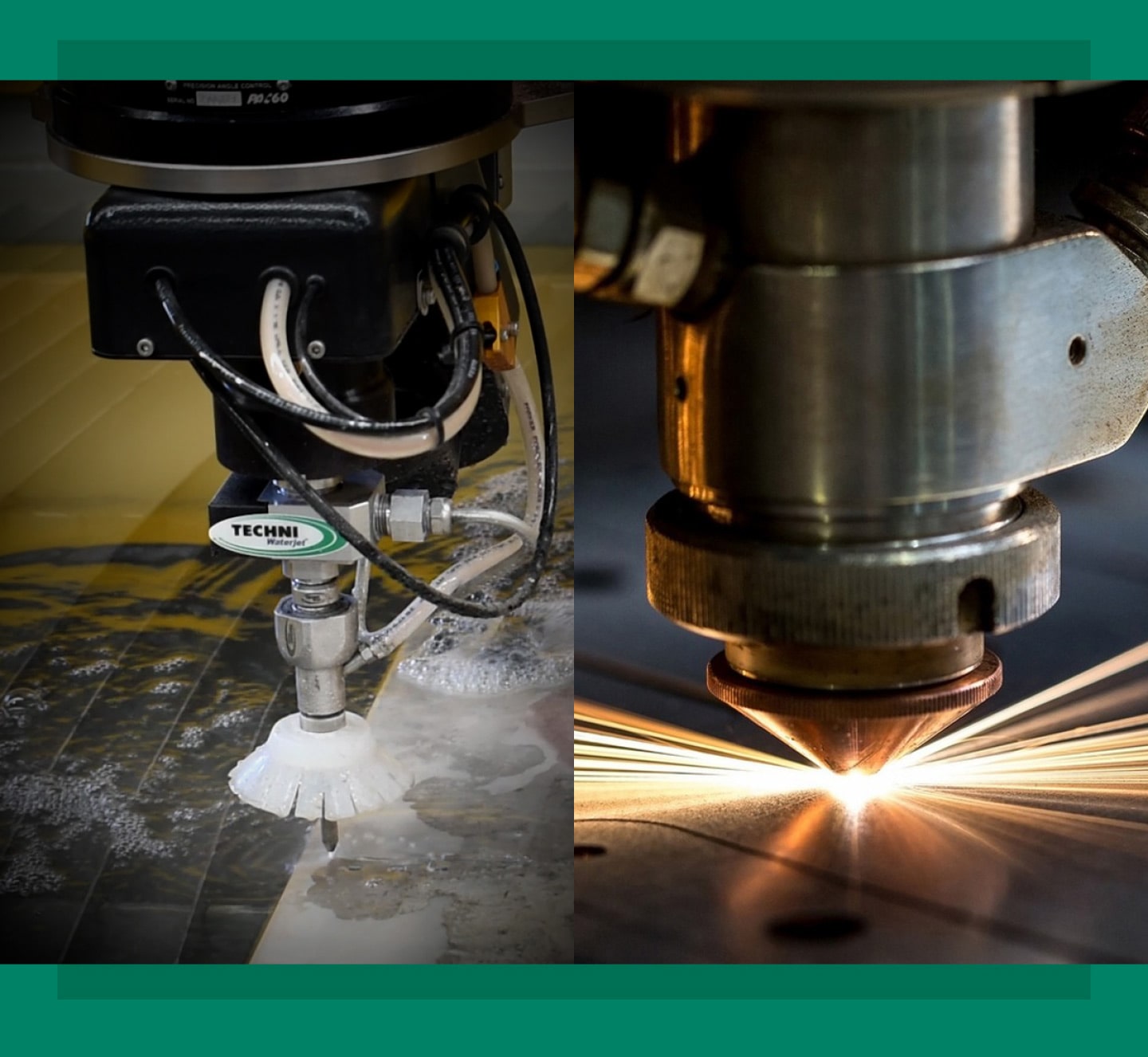
Question 1 What materials can I cut with waterjet cutting and laser cutting methods?
Let’s examine the two processes:
WATERJET CUTTING
Waterjet cutting = Versatility.
Using pressurized water to cut materials means that water jets can cut virtually any material known to man. Abrasives such as Garnet and Aluminium Oxide are often added to mimic the natural water erosion process but at a much-accelerated speed and concentration.
Water jets can cut many materials:
METALS
- Aluminium
- Brass
- Hardox
- Carbon Steel
- Tool Steel
- Copper
- Stainless Steel
- Titanium
- Mild Steel
COMPOSITES
- Aero Fibre
- Carbon Fibre
- Fibreglass
- Kevlar
NATURALS
- Ceramic
- Quartz
- Granite
- Marble
- Cement
- Reconstituted (man-made) Stone
PLASTICS and RUBBER
- Acrylic
- Foam
- Rubber
- PVC
- Polycarbonate
- Silicone
MISCELLANEOUS
- Food
- Insulation materials
- Multi-layer material (ISO wall)
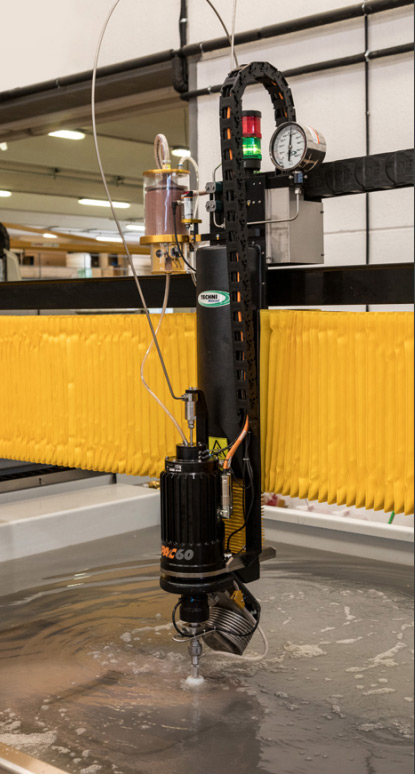
CNC LASER CUTTER
Laser cutting technology uses a guided laser beam to cut through the material using extreme heat focused on the workpiece and compressed gas to blast away the molten material. A modern fiber laser works well with a wide variety of materials, including metals, plastics, and wood. However, materials with different melting points and higher energy transfer like aluminum can be difficult to cut using the laser cutting method.
The near IR wavelength at which a fibre laser operates can cause difficulties in cutting light-colored and highly reflective metals like aluminum, copper, and brass. And the beam will try to pass through transparent materials like glass, polycarbonates, and acrylics.
Specialized laser cutting equipment (usually higher powered – more expensive lasers) is required for this type of laser cutting work.
A laser cutter excels in sheet metal applications where heat transfer into the material is not an issue. Other ideal applications include marking, etching, and engraving where the material does not need to be completely cut.
CNC Laser cutting can cut the following materials:
METALS
- Aluminium
- Brass
- Carbon Steel
- Copper
- Stainless Steel
- Titanium
PLASTICS & RUBBER
- PVC
- Foam
- Rubber
NATURALS
- Wood
- Paper
- Leather
- Cardboard
- Cork
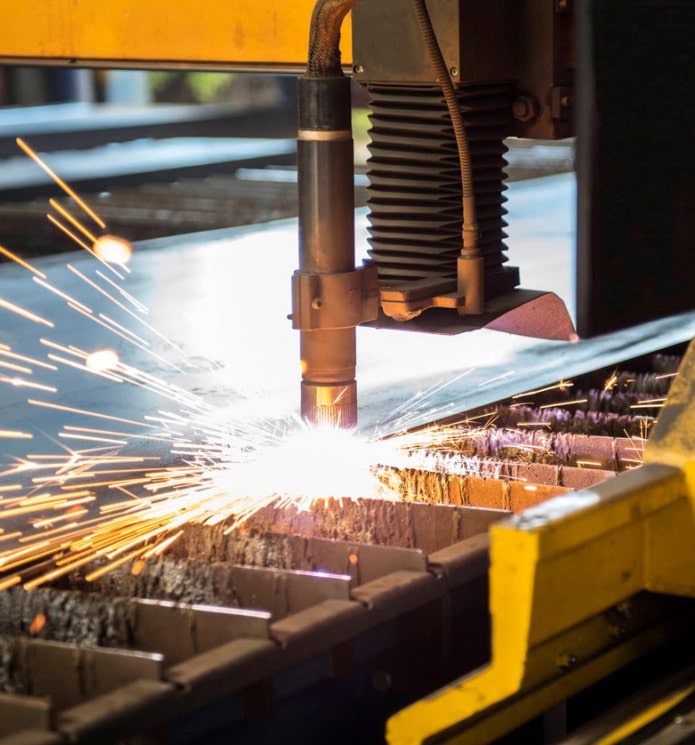
Note that although lasers can cut most non-conductive materials, the intense heat may cause the deformation of certain materials.
Question 2 What thickness can each technology cut?
WATER JET CUTTING TECHNOLOGY
Because waterjet cutting uses an erosion process, it can cut material of almost any thickness. Whether for cutting thin metal or thick mild steel, it is just a matter of matching the speed with the material type and the waterjet cutting head setup. This adjustment is automatic on modern waterjet cutting equipment. Common waterjet cutting applications include cutting steel and aluminium up to 6″ (150mm) thick.
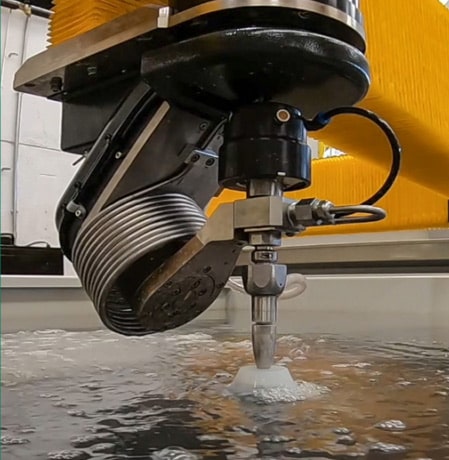
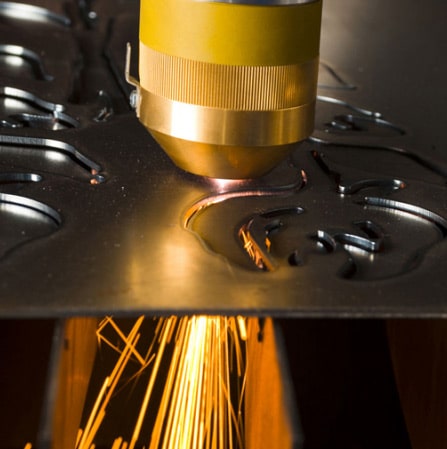
CNC LASER CUTTING TECHNOLOGY
Laser cutting thickness limitations are dependent on the material type and power of the laser. A typical CNC laser cutting machine can cut up to 1/2″ (12mm) thick materials such as steel and aluminium. A typical CNC laser cutting machine in a workshop can cut material up to 1/2″ (12mm) thick materials such as steel and aluminium.
Question 3 What are the safety factors to consider with each cutting method? What would be a better pick for an enclosed workshop?
WATERJET
The safety benefits of waterjet cutting are one of the main reasons it is becoming the favorite cutting technology. Here are a few of the safety benefits:
- No Heat Affected Zone – Using pressurized water to accurately cut means no heat transfer to the material (thermal stress). Therefore, no heat-affected zone where warping might occur. The additional benefit of avoiding a heat-affected zone means finished components can be taken off the cutting table instantly without risk of injury from heat or excessive burrs. Fire extinguishers are not required in the immediate work area.
- No Toxic Emissions – No material is melted during the cutting process. Plastics and rubber can be cut cleanly without emitting toxic fumes.
- Dust Particles Captured By Waterbed – With every type of cutting process, dust and material debris pose a safety hazard to workers in the workshop. The waterbed where the material is placed acts as a natural trap for particles. In a dry cutting process, these would fly into the atmosphere. Submerging the material in water gives further protection. This process has been revolutionary in the stone processing industry, where airborne particles are a health concern for workers.
- Water Jet Cutting Stream Dispersed Into The Waterbed – The water jet cutting takes place within a waterbed where the material is submerged. Even waterjet streams of 60,000 PSI of pressure are dispersed instantly in the waterbed, giving additional safety measures to the cutting process.
Note: Although water jet cutting has these safety features, operators must wear safety goggles and gloves. They must also follow all safety requirements to operate the machine. Safety light curtains can be fitted, and some jurisdictions require them.
CNC LASER CUTTERS
Unfortunately, there aren’t as many safety benefits with CNC laser cutting vs water jet cutting. A laser beam emits a high level of heat and radiation, and some hazards arise. Some of the safety hazards you need to consider when using CNC laser cutting systems include:
- Toxic Emissions – Depending on the type of material you cut, toxic emissions can be created when a high level of heat is transferred to the material. Typically, proper ventilation systems are required around CNC laser cutting systems to minimize the emission of toxic fumes.
- Sparks & Hazardous Particles – When cutting sheet metal parts, the process causes sparks and thin metal filaments in the cutting path. These are a hazard to operators and the workshop itself as it poses a higher chance of injury or a fire.
- Burns From Hot Materials – The use of thermal cutting means the material stays hot for some time after the cutting finishes. Hot material can be hazardous for those who work within the workshop as they could experience burns if they handle the material too soon after the cutting process.
- Improper Guarding – A laser beam is hazardous to the eyes and skin. Even a reasonably priced laser cutter must enclose the cutting process completely.
In answer to the second question regarding waterjet vs. laser cutting technologies, waterjet cutting seems to be a better choice for a safer and higher production rate in the work environment.
Question 4 What are the running costs associated with Waterjet and CNC laser cutters? Which would be more cost-effective for my workshop?
When researching running costs associated with each technology, we have to consider what factors are used in the operation of each machine.
WATERJET CUTTERS
Waterjet machines require 3 main factors to operate.
- Electrical Power Supply
- Water Supply
- Consumable parts like abrasive material
CNC LASER CUTTERS
In terms of laser cutting, there are 3 main expenses to operate the machine.
- Electrical Power Supply
- Gas Supply
- Consumable parts
Question 5 What type of material cutting waste (sheet utilization) am I likely to experience with both cutting methods?
WATERJET CUTTERS
With any cutting method, you will experience offcut waste. But waterjet cutting can maximize its cost efficiency by minimizing the amount of material abrasive waste produced through producing high precision parts very closely together on the sheet of material to be cut. This cost-effectiveness is due to the following factors:
Advanced Nesting Software optimally fits the parts on the sheet, which maximizes material use.
Cold cutting does not deform the sheet or cause material movement. This accuracy and finishing provided by a waterjet cutter make it possible to reduce the gap (waste) between cut parts.
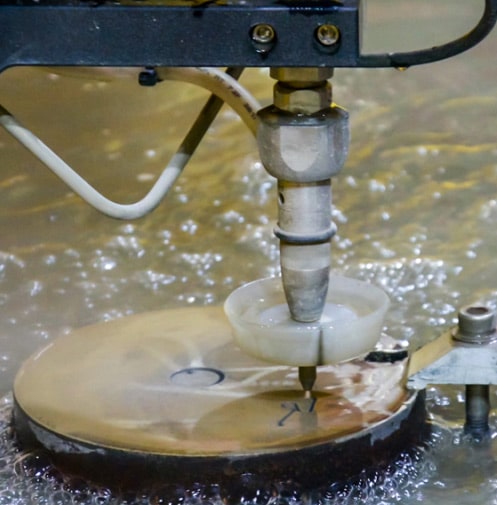
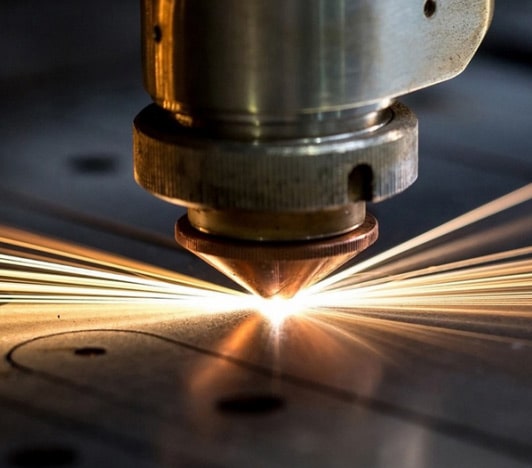
CNC LASER CUTTERS
Over the years, laser cutters have also used nesting software to try and maximize the number of parts on a sheet of material. Although the nesting software capabilities are the same, the minimum cut size slit and finished cuts of the laser are less accurate, inconsistent, and leave dross at the bottom of the sheet.
Sheet warpage is also a consideration when nesting parts and a larger gap may be required. Larger gaps mean more material wastage with CNC laser cutting than waterjet cutting.
Question 6 Will I need to spend additional time and resources on secondary finishing?
Getting every cut right the first time is the key to a productive and efficient workshop. Secondary finishing is a common issue when cuts are not precise. Finishing is a factor many companies involved in cutting metals consider when optimizing cutting processes. And before purchasing a cuttingsystem. Secondary finishing consumes resources, requires additional cost, and slows down productivity to the point where bottlenecks arise within the production line. It is also true that every time you handle materials, the risk of mistakes increases.
WATER JET CUTTER
Waterjets can usually eliminate secondary finishing from the cutting because of the superior edge quality with no hardened surfaces or dross. The process creates a clean smooth cut. Grinding or sanding of an edge is often the final machining process. But abrasive waterjet parts, straight off the machine have a smooth ground finish. Waterjet cut metals can be welded, drilled, tapped, or machined without the need to prepare the edge.
CNC LASER CUTTER
Unfortunately, CNC laser cutting machines require resources to be spent on secondary finishing because the laser cut edge quality is not as clean and smooth when compared to waterjet cutting. The high heat emitted during the laser cut often causes heat distortion, recast, cracking, scale, dross, and structural changes within the material. These require the hard edges of cuts to be ground away before welding, drilling, or machining to avoid problems down the track.
Question 7 What support am I likely to need when running either a water jet or CNC laser machine?
WATER JET CUTTER
When you purchase a Techni system, so begins a relationship.
Techni prides itself on after-sales support. Our Quantum pumps have online monitoring with data retrievable from Techni’s Virtual Maintenance Website. Our technical staff can easily check pump health from the Techni office.
Our team of engineers developed our water jet cutting machines are Windows-based, so we offer online support by remote desktop sharing. It means we can effectively help with issues ranging from simple application questions to detailed machine troubleshooting.
We offer on-site services, including preventive maintenance services, troubleshooting, staff retraining, new applications and latest machine developments to remain competitive, and materials assistance.
CNC LASER CUTTERS
Typically, quality lasers come with a service package for the warranty period. The cost of support after the warranty period must be considered a hidden future operational cost.
Question 8 What preventive maintenance costs are associated with a water jet vs laser cutting machine?
WATERJET CUTTERS
A water jet operator is trained to perform preventative checks and servicing. The main components are the pump and the cutting head.
A high-pressure pump requires high-pressure seal changes and check valve changes approximately every 500-1000hrs. And oil/oil filter changes every 2000hrs. The cutting head requires its orifice changed every 500-1000hrs (if a diamond is used). For abrasive cutting, the focusing tube will need to be changed every 50-100hrs.
The total cost is approx: $4/hr on a typical waterjet setup.
CNC LASER CUTTERS
A laser cutting system requires regular attention to the mechanical, chiller, and extraction systems. These tasks fall under the scope of most factory technicians or mechanics.
If a CNC laser starts to lose efficiency – things become tricky. Typically, laser end-users do not service the beam delivery because of the complex process and hazards involved. Training is not offered because laser optics must be handled with extreme care and can be rendered useless if not handled carefully. Untrained staff can also create a risk to themselves and others if they allow a laser beam to escape into the work area. 1 mW of laser energy can cause permanent blindness and skin burns.
Therefore, a certified laser technician to service and maintain the system must be factored into the running costs.

